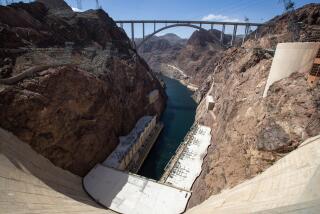Water Board Pays to Replace Thirsty Lawns
- Share via
NOVATO, Calif. — Marin County suffered greatly during the last major drought, in the 1970s--slashing water use between 30% and 65% to avoid running out completely--so it’s not surprising that Marin is serious about conserving in the current dry spell.
Even so, the North Marin Water District is raising eyebrows with its latest attempt to lower water use: It pays customers to tear out their water-guzzling grass lawns and replace them with “xeriscapes” of drought-tolerant plants.
So far, 61 people have signed up for the district’s bounty of $50 for every 100 square feet of sacrificed sod. Even though payouts are lim ited to $310, or 620 square feet, most volunteers are giving up their whole front yards--often 1,000 square feet or more of lush turf.
John Nelson, general manager of the 19,000-customer water district, expects more people to sign up next year, when the utility will publicize the program. For now, it relies on neighbor telling neighbor about the benefits.
There are conditions to the rebate, Nelson said. Lawns must be replaced with other vegetation--preferably desert-like landscaping known as xeriscaping--that is planted to maximize water conservation with humus mulch at least four inches deep, good top soil and a thrifty irrigation system.
Even without promotion, Nelson’s notion is catching the attention of water districts around the state. He said he mails about five information packets a day to other districts.
What the water manager can’t yet tell his colleagues is why people sign up. Even if it saves them money three or more years down the road, it can cost residents big money up front to replace the lawn.
“We don’t really have a good handle on why people are doing it,” he said. “If you have a contractor come out and replace your front yard, it could run you $3,000. Even if you do it yourself, it would still be about $1,000.
“We think the reason people are doing it is primarily for saving time, not money. They want to get out from under the yoke of lawn maintenance. These are people who are simply tired of watering, fertilizing and, most of all, cutting their lawns.”
And tired of paying for the privilege. In arid Novato, about 30 miles north of San Francisco, a typical lawn drinks enough water each year to cover itself to a depth of 33 inches, or nearly three feet. Losing the lawn could cut water bills by 40%, Nelson said.
Savings for homeowners are clear, Nelson said, but it is still too early to tell exactly how much water the year-old program saves the district. However, the water records of each program participant are being plotted by computer so the district can immediately see results this summer.
Experience tells Nelson the savings can be enormous. While wrestling with long-term city water supply problems nearly seven years ago, Nelson noticed that several new townhouse projects used wildly different amounts of water.
He traced the difference to landscaping and discovered that the most frugal projects used a lot of trees, bushes and flowers, and relatively little grass. One project impressed him because it used turf only in high-profile areas while the rest of the lot was planted with flowering shrubs.
“When you’d first glance, it looked like there was a ton of turf,” Nelson said, “but when you measured and calculated, there was really much less grass per (housing) unit than at other developments.”
He said he knew then that grass had a “very dramatic” effect on domestic water consumption, but it took months of careful monitoring and computer work to determine just how dramatic.
“We used to guess that about half of all outside water use was for turf--but it’s not true,” he said. “It’s closer to 90%.”
He said he and his staff realized that replacing that grass with something, almost anything, would save very large amounts of water--and do so relatively cheaply.
Nelson persuaded his district’s board of directors to offer incentives to developers to limit lawns in their projects. If they cut their grass to 800 square feet for single-family homes, 400 square feet for condominiums and 200 square feet for apartments, they could save up to $310 a unit on water hook-up fees.
More than 95% of the condominium and apartment developments from 1986 to 1989 signed up for the program, Nelson said, because the developers themselves were in charge of landscaping, letting them enjoy both lower hook-up fees and lower landscape maintenance charges.
In that same time, however, not even one single-family home took part. Nelson speculated that this was because developers, who would have benefited from lower water hook-up fees, generally did not landscape single-family homes. The home buyers, who did, could not directly benefit from low hook-up fees.
That changed a year ago, when new homeowners were offered up to $310 to not plant grass in their bare yards. After dozens of people jumped for that offer, it was extended to existing homeowners who agreed to replace lawns they already had planted.
The district will not pay homeowners who replace lawns with patios, decking or pools.
“We’re trying to save our money to reward people who go on out and replace grass they otherwise wouldn’t replace,” Nelson said. “With decks and patios, we figure the main motivation (for building them) is the structure itself, not conservation.”
Also forbidden are lawns that are simply paved over with concrete or gravel--as more than one resident has suggested.
“We’re using our other customers’ money,” Nelson said, “so we want to be consistent with the rest of the community when it comes to aesthetics.”
Nelson said the program cost the district about $15,000 this year--cash he said was well spent in light of a water shortage predicted for booming, middle-class Novato early in the next century.
“We look at this as avoided capital costs,” he explained, “so it’s really not costing us a dime.”
More to Read
Sign up for Essential California
The most important California stories and recommendations in your inbox every morning.
You may occasionally receive promotional content from the Los Angeles Times.













